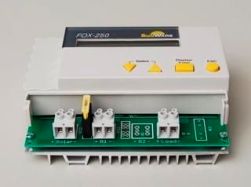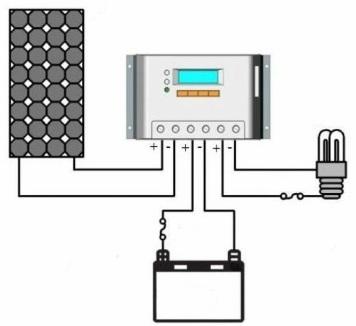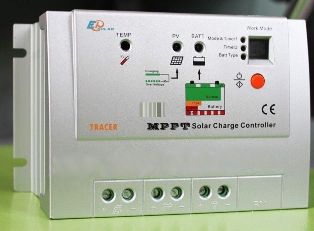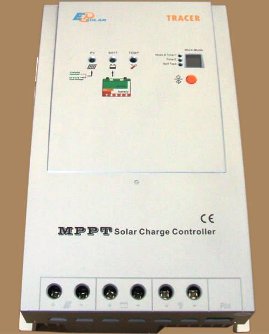Categories: Featured Articles » Autonomous power supply
Number of views: 44783
Comments on the article: 1
Solar controllers
The principle of operation of the controllers for charging solar panels, a device that should be considered when choosing
 In modern solar power plants, different schemes for connecting current sources are used to transfer the generated electricity to working batteries. They use not the same algorithms, are based on microprocessor technologies, called controllers.
In modern solar power plants, different schemes for connecting current sources are used to transfer the generated electricity to working batteries. They use not the same algorithms, are based on microprocessor technologies, called controllers.
How solar charge controllers work
Electricity generated by the solar battery can be transmitted to storage batteries:
1. directly, without the use of switching devices and control devices,
2. through the controller.
In the first method, the electric current from the source will go to the batteries and will increase the voltage at their terminals. Initially, it will reach a certain limit value, depending on the design (type) of the battery and the ambient temperature. Then will overcome the recommended level.
At the initial stage of the charge, the circuit works fine. And here extremely undesirable processes begin: the continued supply of the charging current causes an increase in voltage in excess of the permissible values (of the order of 14 V), a recharge occurs with a sharp increase in the temperature of the electrolyte, which leads to its boiling with an intense discharge of distilled water vapor from the elements. Sometimes until the containers dry completely. Naturally, the battery life is sharply reduced.
Therefore, the task of limiting the charging current is solved by controllers or manually. The last way: constantly monitor the voltage value by devices and switch the switches with your hands so ungrateful that it exists only in theory.
See also: Solar Power For Home

Typical controller connection diagram
Algorithms for solar charge controllers
By the complexity of the method of limiting the maximum voltage, the devices are manufactured according to the principles of:
1. Off / On (or On / Off), when the circuit simply commutes the batteries to the charger according to the voltage across the terminals,
2. pulse-width (PWM) transforms,
3. Scan point maximum power.
Principle # 1: Off / On Circuit
This is the simplest but most unreliable method. Its main drawback is that with increasing voltage at the terminals of the battery to the limit value of the full charge of the capacity does not occur. In this case, it reaches approximately 90% of the nominal value.
Batteries constantly have a regular lack of energy, which significantly reduces their useful life.
Principle # 2: PWM Controller Circuit
The abbreviated designation of these devices in English is: PWM. They are available on the basis of chip designs. Their task is to control the power unit to regulate the voltage at its input in a given range using feedback signals.
PWM controllers can additionally:
-
take into account the temperature of the electrolyte with an integrated or remote sensor (the latter method is more accurate),
-
create temperature compensations for charging voltages,
-
tune to a specific type of battery (GEL, AGM, liquid acid) with different voltage graphs at the same points.
Increasing the functions of PWM controllers increases their cost and reliability.

Solar Schedule
Principle 3: Scanning the maximum power point
Such devices are designated in English by MPPT. They also work by the method of pulse-width converters, but are extremely accurate because they take into account the largest amount of power that solar panels can give.This value is always accurately determined and entered into the documentation.
For example, for 12 V solar cells, the maximum power return point is about 17.5 V. An ordinary PWM controller will stop charging the battery when the voltage reaches 14 - 14.5 V, and working on MPPT technology will allow additional use of the solar battery up to 17.5 IN.
With increasing depth of discharge of the batteries, energy losses from the source increase. MRI controllers reduce them.
The nature of the voltage tracking, corresponding to the output of the maximum power of the solar battery of 80 watts, is demonstrated by an average graph.
In this way, MRI controllers, using pulse-width conversion in all battery charge cycles, increase the efficiency of the solar battery. Depending on various factors, savings may amount to 10-30%. In this case, the output current from the battery will exceed the input current from the solar battery.

The main parameters of solar charge controllers
When choosing a controller for a solar battery, in addition to knowing the principles of its operation, attention should be paid to the conditions for which it is designed.
The main indicators of the devices are:
-
input voltage value
-
the value of the total power of solar energy,
-
nature of the connected load.
Solar voltage
The controller can be supplied with voltage from one or more solar panels connected in different ways. For the correct operation of the device, it is important that the total value of the voltage supplied to it, taking into account the idle speed of the source, does not exceed the limit value specified by the manufacturer in the technical documentation.
In this case, a margin (reserve) of ≥ 20% should be made due to a number of factors:
-
it’s no secret that certain parameters of the solar battery can sometimes be slightly overestimated for advertising purposes,
-
the processes occurring on the Sun are not stable in nature, and with abnormally increased bursts of activity, energy transfer is possible, which creates an open circuit voltage of the solar battery above the calculated limit.
Solar power
It is important for choosing a controller because the device must be able to reliably transfer it to working batteries. Otherwise, it will simply burn.
To determine the power (in watts), the magnitude of the current output from the controller (in amperes) is multiplied by the voltage (in volts) generated by the solar battery, taking into account the 20% margin created for it.
The nature of the connected load
You need to understand the purpose of the controller. You should not use it as a universal power source by connecting various household devices to it. Of course, some of them will be able to work normally without creating abnormal conditions.
But ... how long will this go on? The device operates on the basis of pulse-width transformations, uses microprocessor and transistor technologies, which only take into account the load battery characteristicsrather than random consumers with complex transients during switching and the changing nature of power consumption.

Manufacturers at a Glance
The production of controllers for solar power plants involved in many countries. The products of companies are popular on the Russian market:
-
Morningstar Corporation (leading US manufacturer),
-
Beijing Epsolar Technology (operating since 1990 in Beijing),
-
AnHui SunShine New Energy Co (China),
-
Phocos (Germany),
-
Steca (Germany),
-
Xantrex (Canada).
Among them, you can always choose a reliable controller model that is most suitable for the specific operating conditions of solar power plants with certain technical characteristics. To do this, simply use the recommendations of this article.
Read also on this topic: Inverter for home solar power station
See also at bgv.electricianexp.com
:

